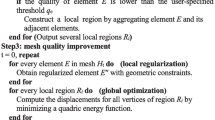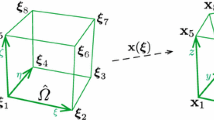Abstract
For finite element analyses within highly elastic and plastic structural domains, hexahedral meshes have historically offered some benefits over tetrahedral finite element meshes in terms of reduced error, smaller element counts, and improved reliability. However, hexahedral finite element mesh generation continues to be difficult to perform and automate, with hexahedral mesh generation taking several orders of magnitude longer than current tetrahedral mesh generators to complete. Thus, developing a better understanding of the underlying constraints that make hexahedral meshing difficult could result in dramatic reductions in the amount of time necessary to prepare a hexahedral finite element model for analysis. In this paper, we present a survey of constraints associated with hexahedral meshes (i.e., the conditions that must be satisfied to produce a hexahedral mesh). In presenting our formulation of these constraints, we will utilize the dual of a hexahedral mesh. We also discuss how incorporation of these constraints into existing hexahedral mesh generation algorithms could be utilized to extend the class of geometries to which these algorithms apply. We also describe a list of open problems in hexahedral mesh generation and give some context for future efforts in addressing these problems.






















Similar content being viewed by others
References
Means S, Smith AJ, Shepherd JF, Shadid J, Fowler J, Wojcikiewicz R, Mazel T, Smith GD, Wilson BS (2006) Reaction modeling of calcium dynamics with realistic ER geometry. Biophys J 91(2):537–557
Milton KA (1996) Finite-element quantum field theory. In: Proceedings of the XIVth international symposium on lattice field theory, Nucl Phys B (Proc. Suppl.) 53 (1997): 847–849
Meier DL (1999) Multidimensional astrophysical structural and dynamical analysis. I. Development of a nonlinear finite element approach. Astrophys J 518:788–813
Loriot M (2006) Tetmesh-ghs3d v3.1 the fast, reliable, high quality tetrahedral mesh generator and optimiser (see http://www.simulog.fr/mesh/tetmesh3p1d-wp.pdf).
White DR, Leland RW, Saigal S, Owen SJ (2001) The meshing complexity of a solid: an introduction. In: Proceedings, 10th international meshing roundtable. Sandia National Laboratories, pp 373–384
White DR, Saigal S, Owen SJ (2003) Meshing complexity of single part CAD models. In: Proceedings, 12th international meshing roundtable. Sandia National Laboratories, pp 121–134
Weingarten VI (1994) The controversy over hex or tet meshing. Mach Des 66:74–78
Cifuentes AO, Kalbag A (1992) A performance study of tetrahedral and hexahedral elements in 3-D finite element structural analysis. Finite Elem Anal Des 12(3–4):313–318
Steven E. Benzley, Ernest Perry, Karl Merkley, Brett Clark (1995) A comparison of all hexagonal and all tetrahedral finite element meshes for elastic and elasto-plastic analysis. In: Proceedings, 4th international meshing roundtable. Sandia National Laboratories, pp 179–191
Bussler ML, Ramesh A (1993) The eight-node hexahedral elements in FEA of part designs. Foundry Manag Technol 121 (11): 26–28
Steven J. Owen (1998) A survey of unstructured mesh generation technology (available at http://www.andrew.cmu.edu/user/sowen/survey/index.html). Accessed Sep
Blacker TD, Mitchiner JL, Phillips LR, Lin YT (1988) Knowledge system approach to automated two-dimensional quadrilateral mesh generation. Comput Eng 3:153–162
Bill Thurston (1993) Geometry in action: Hexahedral decomposition of polyhedra (available from http://www.ics.uci.edu/ eppstein/gina/thurston-hexahedra.html). Accessed Oct
Peter J. Murdoch (1995) The spatial twist continuum: a dual representation of the all hexahedral finite element mesh. Published Doctoral Dissertation, Brigham Young University, December
Peter J. Murdoch, Steven E. Benzley (1995) The spatial twist continuum. In: Proceedings, 4th international meshing roundtable. Sandia National Laboratories, pp 243–251, October
Scott A. Mitchell (1996) A characterization of the quadrilateral meshes of a surface which admit a compatible hexahedral mesh of the enclosed volumes. In: 13th Annual symposium on theoretical aspects of computer science, vol 1046. Lecture notes in computer science, pp 465–476
David Eppstein (1996) Linear complexity hexahedral mesh generation. In: 12th ACM symposium on computational geometry. ACM Press, New York, pp 58–67
Schwartz A, Ziegler GM (2004) Construction techniques for cubical complexes, odd cubical 4-polytopes, and prescribed dual manifolds. Exp Math 13(4):385–413
Jonathan Richard Shewchuk (2002) What is a good linear element? Interpolation, conditioning, and quality measures. In Proceedings, 11th international meshing roundtable. Sandia National Laboratories, pp 115–126
Knupp PM (2001) Algebraic mesh quality metrics. SIAM J Sci Comput 23(1):193–218
Knupp P, Mitchell SA (1999) Integration of mesh optimization with 3D all-hex mesh generation, LDRD subcase 3504340000, final report. SAND 99-2852, October
VP Garimella RV, Shashkov MJ Mesh untangling. LAU-UR-02-7271, T-7 Summer Report 2002
Knupp PM (2000) Hexahedral mesh untangling and algebraic mesh quality metrics. In: Proceedings, 9th international meshing roundtable. Sandia National Laboratories, pp 173–183, October
Freitag LA, Plassmann P (2000) Local optimization-based simplicial mesh untangling and improvement. Int J Numer Methods Eng 49(1):109–125
Folwell NT, Mitchell SA (1999) Reliable whisker weaving via curve contraction. Eng Comput 15:292–302
Bern M, Eppstein D (2001) Flipping cubical meshes. In: Proceedings, 10th international meshing roundtable. Sandia National Laboratories, pp 19–29
Bern M, Eppstein D, Erickson J (2002) Flipping cubical meshes. Eng Comput 18(3):173–187
Tautges TJ, Knoop S (2003) Topology modification of hexahedral meshes using atomic dual-based operations. In: Proceedings, 12th international meshing roundtable. Sandia National Laboratories, pp 415–423
Suzuki T, Takahashi S, Shepherd JF (2005) Practical interior surface generation method for all-hexahedral meshing. In: Proceedings, 14th international meshing roundtable. Sandia National Laboratories, pp 377–397
Schneiders pyramid open problem, http://www-users.informatik.rwth-aachen.de/ roberts/open.html
Melander DJ, Tautges TJ, Benzley SE (1997) Generation of multi-million element meshes for solid model-based geometries: The dicer algorithm. AMD Trends Unstructured Mesh Generation 220:131–135
Mitchell SA, Tautges TJ (1995) Pillowing doublets: refining a mesh to ensure that faces share at most one edge. In: Proceedings, 4th international meshing roundtable. Sandia National Laboratories, pp 231–240
Melander DJ (1997) Generation of multi-million element meshes for solid model-based geometries: The Dicer Algorithm. Published Master’s Thesis, Brigham Young University, April
Borden MJ, Shepherd JF, Benzley SE (2002) Mesh cutting: fitting simple all-hexahedral meshes to complex geometries. In: Proceedings, 8th International society of grid generation conference
Jankovich SR, Benzley SE, Shepherd JF, Mitchell SA (1999) The graft tool: an all-hexahedral transition algorithm for creating multi-directional swept volume mesh. In: Proceedings, 8th international meshing roundtable. Sandia National Laboratories, pp 387–392
Borden MJ, Benzley SE, Shepherd JF (2002) Coarsening and sheet extraction for all-hexahedral meshes. In: Proceedings, 11th international meshing roundtable. Sandia National Laboratories, pp 147–152
Tautges TJ, Blacker TD, Mitchell SA (1996) Whisker weaving: a connectivity-based method for constructing all-hexahedral finite element meshes. Int J Numer Methods Eng 39:3327–3349
Schneiders R (1997) An algorithm for the generation of hexahedral element meshes based on an octree technique. In: Proceedings, 6th international meshing roundtable. Sandia National Laboratories, pp 183–194
Yerry MA, Shephard MS (1984) Three-dimensional mesh generation by modified octree technique. Int J Numer Methods Eng 20:1965–1990
Shephard MS, Georges MK (1991) Three-dimensional mesh generation by finite octree technique. Int J Numer Meth Eng 32:709–749
Zhang Y, Bajaj C (2005) Adaptive and quality quadrilateral/hexahedral meshing from volumetric imaging data. In: Proceedings, 13th international meshing roundtable. Sandia National Laboratories, pp 365–376
Cook WA, Oakes WR (1982) Mapping methods for generating three-dimensional meshes. Comput Mech Eng CIME Res Suppl:67–72
Dannenhoffer JF (III) (1991) A block-structuring technique for general geometries. In: 29th Aerospace sciences meeting and exhibit, vol AIAA-91-0145, January
XYZ Scientific Applications, Inc. (2006) Truegrid: High quality hexahedral grid and mesh generation for fluids and structures (available from http://www.truegrid.com). Accessed Oct
Pointwise (2006) Gridgen—reliable CFD meshing (available from http://www.pointwise.com/gridgen/), Accessed Oct
ANSYS (2006) ANSYS ICEM CFD (available from http://www.ansys.com/products/icemcfd.asp), October
White DR (1996) Automatic quadrilateral and hexahedral meshing of Pseudo-Cartesian geometries using virtual subdivision. Published Master’s Thesis, Brigham Young University, June
White DR, Lai M, Benzley SE, Sjaardema GD (1995) Automated hexahedral mesh generation by virtual decomposition. In: Proceedings, 4th international meshing roundtable. Sandia National Laboratories, pp 165–176, October
Knupp P (1998) Next-generation sweep tool: a method for generating all-hex meshes on two-and-one-half dimensional geometries. In: Proceedings, 7th international meshing roundtable. Sandia National Laboratories, pp 505–513, October
Staten ML, Canann SA, Owen SJ (1998) BMSWEEP: locating interior nodes during sweeping. In: Proceedings, 7th international meshing roundtable. Sandia National Laboratories, pp 7–18, October
Roca X, Sarrate J, Huerta A (2004) Surface mesh projection for hexahedral mesh generation by sweeping. In: Proceedings, 13th international meshing roundtable, vol SAND 2004-3765C. Sandia National Laboratories, pp 169–180, September
Lai M, Benzley SE, White DR (2000) Automated hexahedral mesh generation by generalized multiple source to multiple target sweeping. Int J Numer Methods Eng 49(1):261–275
Lai M, Benzley SE, Sjaardema GD, Tautges TJ (1996) A multiple source and target sweeping method for generating all-hexahedral finite element meshes. In: Proceedings, 5th international meshing roundtable. Sandia National Laboratories, pp 217–228, October
Shepherd JF, Mitchell SA, Knupp P, White DR (2000) Methods for multisweep automation. In: Proceedings, 9th international meshing roundtable. Sandia National Laboratories, pp 77–87, October
Blacker TD (1996) The cooper tool. In: Proceedings, 5th international meshing roundtable. Sandia National Laboratories, pp 13–30, October
Whitely M, White DR, Benzley SE, Blacker TD (1996) Two and three-quarter dimensional meshing facilitators. Eng Comput 12:155–167
Mitchell SA (1997) Choosing corners of rectangles for mapped meshing. In: 13th Annual symposium on computational geometry. ACM Press, New York, pp 87–93
Mitchell SA (1997) High fidelity interval assignment. In: Proceedings, 6th international meshing roundtable. Sandia National Laboratories, pp 33–44, October
Shepherd JF, Benzley SE, Mitchell SA (2000) Interval assignment for volumes with holes. Int J Numer Methods Eng 49(1):277–288
White DR, Tautges TJ (2000) Automatic scheme selection for toolkit hex meshing. Int J Numer Methods Eng 49(1):127–144
Lu Y, Gadh R, Tautges TJ (1999) Volume decomposition and feature recognition for hexahedral mesh generation. In: Proceedings, 8th international meshing roundtable. Sandia National Laboratories, pp 269–280, October
Tautges TJ, Liu SSs, Lu Y, Kraftcheck J, Gadh R (1997) Feature recognition applications in mesh generation. AMD Trends Unstructured Mesh Generation 220:117–121
Kraftcheck J (2000) Virtual geometry: a mechanism for modification of CAD model topology for improved meshability. Published Master’s Thesis, Department of Mechanical Engineering, University of Wisconsin, December
Schindler Weiler FR, Schneiders R (1996) Automatic geometry-adaptive generation of quadrilateral and hexahedral element meshes for FEM. In: Proceedings, 5th international conference on numerical grid generation in computational field simulations. Mississippi State University, pp 689–697, April
Walton KS, Benzley SE, Shepherd JF (2002) Sculpting: an improved inside-out scheme for all-hexahedral meshing. In: Proceedings, 11th international meshing roundtable. Sandia National Laboratories, pp 153–159, September
Zhang Y, Bajaj C, Xu G (2005) Surface smoothing and quality improvement of quadrilateral/hexahedral meshes with geometric flow. In: Proceedings, 14th international meshing roundtable. Sandia National Laboratories, pp 449–468, September
Blacker TD, Meyers RJ (1993) Seams and wedges in plastering: a 3D hexahedral mesh generation algorithm. Eng Comput 2(9):83–93
Muller-Hannemann M (1998) Hexahedral mesh generation by successive dual cycle elimination. In: Proceedings, 7th international meshing roundtable. Sandia National Laboratories, pp 365–378, October
Calvo NA, Idelsohn SR (2000) All-hexahedral element meshing: generation of the dual mesh by recurrent subdivision. Comput Methods Appl Mech Eng 182:371–378
Staten ML, Owen SJ, Blacker TD (2005) Unconstrained paving and plastering: a new idea for all hexahedral mesh generation. In: Proceedings, 14th international meshing roundtable. Sandia National Laboratories, pp 399–416, September
Owen SJ, Saigal S (2000) H-morph an indirect approach to advancing front hex meshing. Int J Numer Methods Eng 49(1):289–312
Richards S, Benzley SE, Shepherd JF, Stephenson MB (2005) DTH exing: creation of semi-structured all-hexahedral meshes based on coarse tetrahedral primitives. Sandia Doc Num 5237908, November
Richards S, Benzley SE, Shepherd JF, Stephenson MB (2003) DTH exing: an improved all-hexahedral meshing scheme using general coarsening tools. SAND2003-2724A and SAND2003-2818P
Author information
Authors and Affiliations
Corresponding author
Rights and permissions
About this article
Cite this article
Shepherd, J.F., Johnson, C.R. Hexahedral mesh generation constraints. Engineering with Computers 24, 195–213 (2008). https://doi.org/10.1007/s00366-008-0091-4
Received:
Accepted:
Published:
Issue Date:
DOI: https://doi.org/10.1007/s00366-008-0091-4




